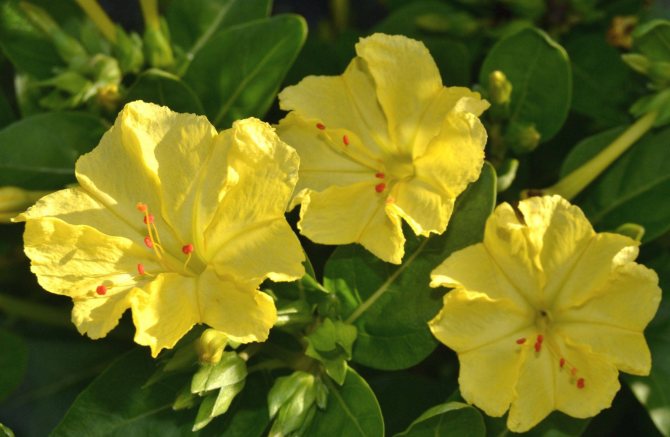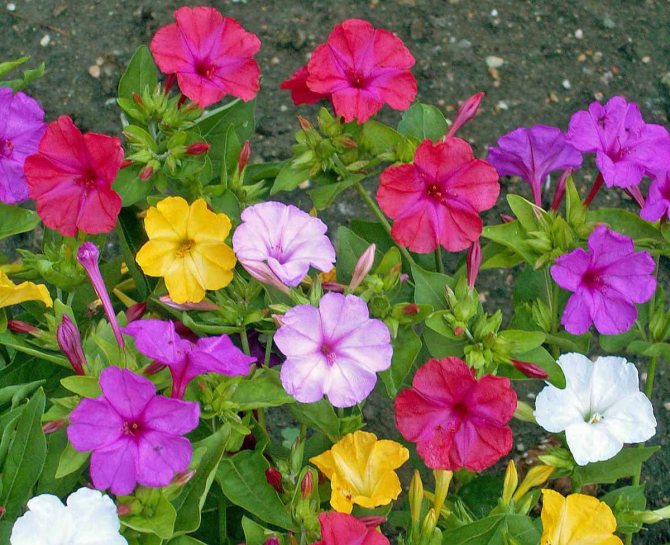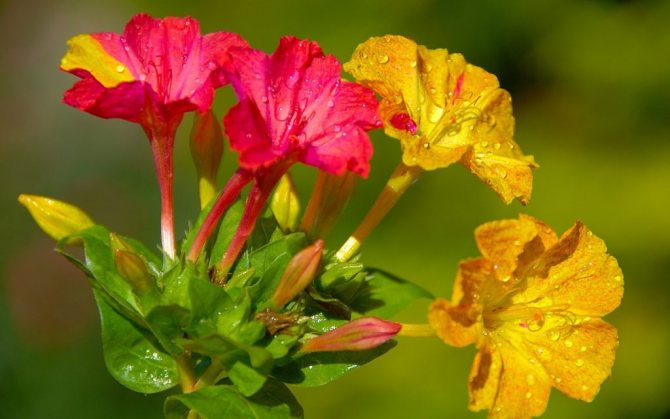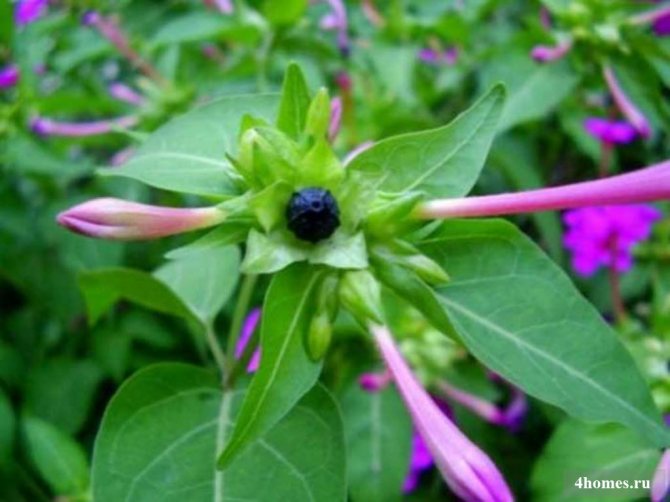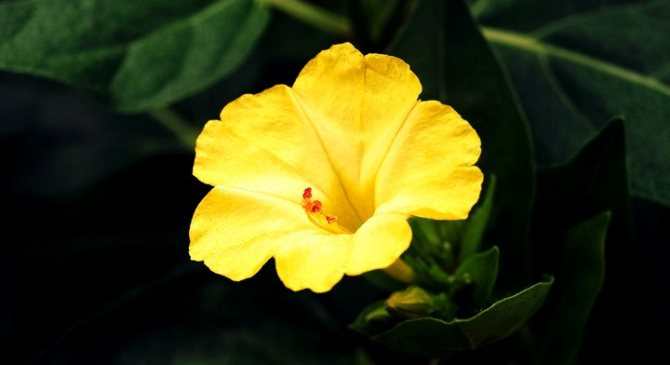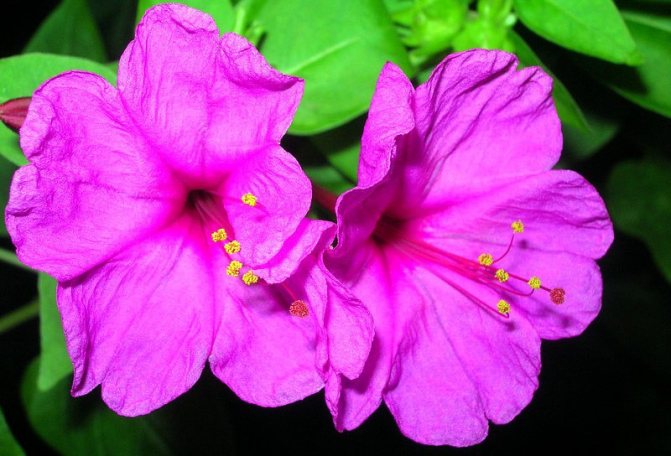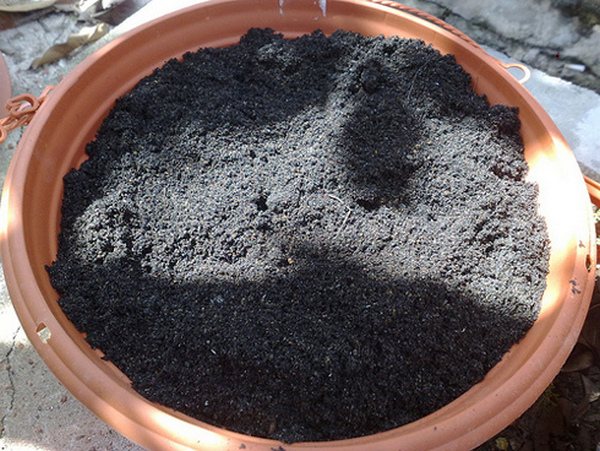Mirabilis is a charming member of the niktagin family, the main feature of which is the night opening of the buds. It is at night that the plant reveals its simple but touching beauty. In places of natural growth - warm tropics and South America - the flower is perennial and has up to fifty species. In the climatic conditions of our country, it is grown as an annual, since severe winters and frequent temperature changes do not allow the root system to get the opportunity to develop for the next year.
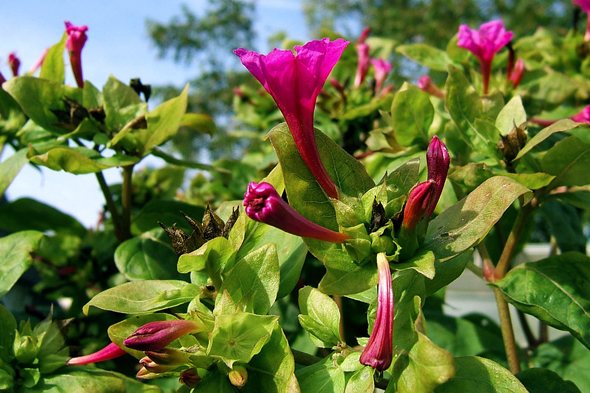
In Russia, mirabilis is incredibly popular among those flower growers who are just starting to get acquainted with ornamental crops, which is explained by the ease of cultivation and subsequent care. Flowering begins at the end of May, and continues until the onset of real autumn frosts. Tall, up to 70-80 cm, the plant exudes a delicate, refined aroma, and large gramophone inflorescences bloom in cloudy weather and at night.
Night mystery
Mexicans not just so affectionately nicknamed the flower "night beauty mirabilis". In the photo during the day, he looks like an ugly duckling from the fairy tale of the same name, but as soon as the sun sets, the dull bush turns into a “beautiful swan”. And then the one who previously spoke disparagingly about the unprepossessing form of the flower freezes in mute delight, struck not only by its beauty: the mirabilis has another "ace up its sleeve".
Under the cover of night, a magical transformation begins: one after another, multi-colored gramophones are revealed, which immediately spread their vibes throughout the garden, filling the air with an extraordinary aroma. There is a feeling of some pleasant unreality, as if you were in a fairy tale. It's night, the moon is shining softly, like diamonds are sparkling stars, and you catch yourself thinking that you can almost hear the music pouring from live mini-gramophones.
Such fabulous surprises can be presented to us by a seemingly quiet mirabilis. It is extremely difficult to make a photo in a flowerbed in good quality only in the light of the moon or with one flashlight. To capture the wonderful metamorphosis for memory, photographers have to install special lighting.
Top dressing
Fertilizing a night beauty has a positive effect on the development of the plant as a whole. Top dressing should be carried out no more than 1 time per month. Throughout the season, fertilizers are applied no more than 3 times.


They need to be carried out:
- At the seedling stage. 2 weeks after the appearance of the first shoots in the soil, the choice is made: "Krepysh", "Zdraven", "Mortar".
- During the growing season. Organic fertilizers (humus) diluted in a large amount of water at a rate of 1:12 are suitable.
- Mid-July. Complex feeding with phosphorus and potassium content.
- End of August - beginning of September. Any ready-made dressing with a minimum nitrogen content.
Many gardeners do not recommend using fresh mullein and compost, this will lead to acidification of the soil, the result will be rotting of the plant's rhizomes. All dressings must be applied strictly to the root.


Varieties
Despite the fact that the flowers that are next to each other are constantly pollinated and, as a result, it is impossible to guess what color mirabilis will bloom next time, scientists managed to breed certain varieties.
6 popular and most beautiful varieties:
- Tea Time Red. A dense bush of medium size, resembling a ball, the stems of a pale green color are distinguished by knotty and strongly branch upwards. The leaves are oblong, smooth and noticeably darker in shade than the stems. The flowers are deep pink, reminiscent of small funnels. The variety is maximally resistant to temperature extremes and diseases, blooms from summer until the first frost, and therefore is most often used in cold regions.
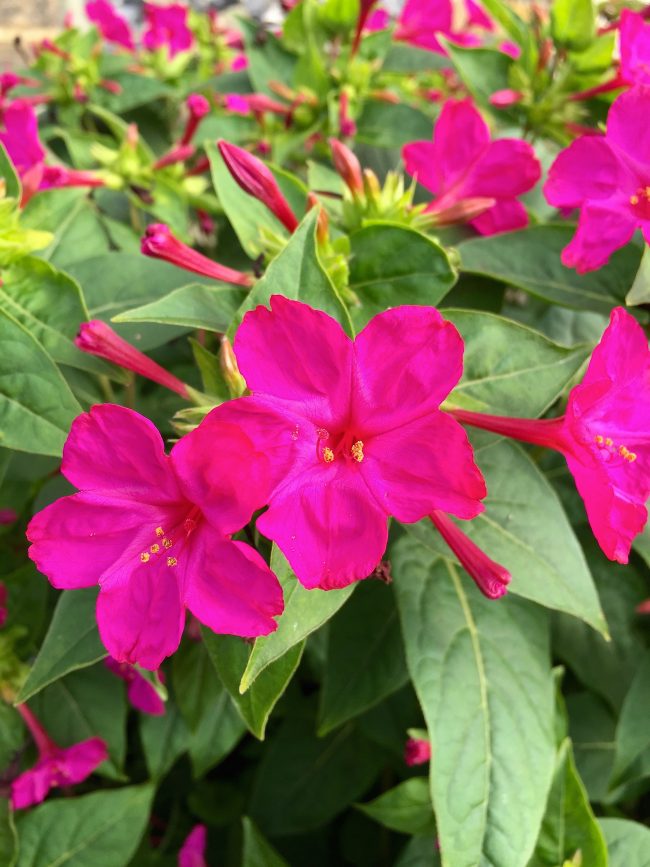

- Iolanta is a spherical bush about 50 cm high with thick and strong stems - knotty, branching at the top. The flowers are funnel-shaped, medium-sized, stand out among other varieties with a bright palette with stripes in the form of strokes. The flowering period lasts from late June until the first frost.
Variegated flowers of mirabilis variety Iolanta
- Elvira is a medium-sized rounded shrub with some branches up to a meter high. Leaves are dark green in color, oblong in shape and have pointed tips. This variety also differs in the size of the flowers - they reach almost 4 cm and have a bright color.
- Red lollipop. A shrub about a meter high is characterized by latitude, the stems are smooth, highly developed, branch upwards and have a shade of light green. It differs from the others in especially large flowers - they grow up to 6 cm in diameter, and are also distinguished by the shape of the petals - the "funnel" is wavy at the edges. The color is bright, the plant is resistant to diseases and extremely unpretentious in care.
Mirabilis variety red lollipop
- Tea Time Formula Mixture. A wide bush-ball of medium parameters with branches up to 90 cm high. The leaves are oblong, located more densely towards the top and pointed at the ends. Stems are absolutely naked and smooth below, but strongly branch towards the ends. The flowers are small, 2-3 cm in diameter in the form of a gramophone, differ in variegated tones, wavy at the ends.
- Yalapa is a medium-sized shrub of about 60 cm with green stems and succulent leaves, completely covered with tubular flowers. They can be either of the same tone or multi-colored, even like striated lines. Begins to bloom after the decline in sunlight activity at about 4:00 pm, for which the plant received the nickname "4 pm". Blooms until late autumn.
Yalapa is the most popular mirabilis variety
Views
There are six common varieties of mirabilis, which are often grown by flower growers.
Yalapa
It is a popular type and is suitable for decorating large flower beds. The advantages of Yalap include the following:
- multi-colored petals;
- unpretentious care;
- abundant flowering.
Such a flower is planted in early April so that in summer you can enjoy the flowering of mirabilis.
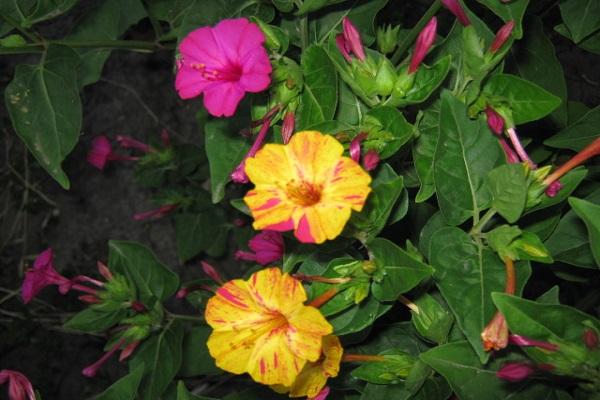

Multi-flowered
A perennial herbaceous seedling that grows up to eighty centimeters. The multi-flowered plant has powerful erect stems, which are covered with ovoid leaves. At the end of spring, inflorescences with a diameter of 4-7 cm form on the bushes of mirabilis.
Round-leaved
A compact shrub that grows well even in small pots. The height of the round-leaved flower does not exceed thirty centimeters. The leaves of such a mirabilis have an oval shape, their length is 7-8 cm. In the upper part of the seedlings, flowers are formed that bloom in the evening.
Blood red
It is a plant with fragrant reddish flowers that only open in the evening after three o'clock. The shrub of mirabilis is medium-sized, its height is 85 cm. The stems of the blood-red sapling are branched and at the same time erect.
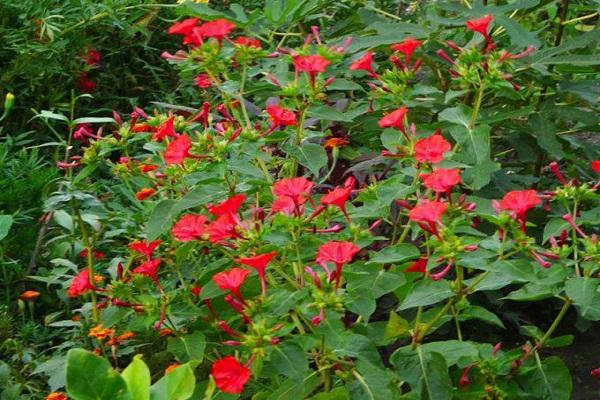

Bright red
It is a wide leafy flower bush with thick stems with a perfectly smooth surface. With proper care, the seedling grows up to ninety centimeters. The leaves of the plant are oval, colored green. The seedling begins to bloom in June.
Purple
This is a medium-sized variety of mirabilis that can be planted both outdoors and indoors. The main difference from other types of flower seedlings is the bright purple color of the petals. Flowers bloom in late spring and June.
Mirabilis: landing and leaving
The plant propagates by seed, but many gardeners use the method of cuttings and occasionally dividing.
Mirabilis. Growing
The night beauty is not particularly whimsical in reproduction and care, it is quite simple to grow it.
Three ways:
- Germination. Seeds are collected from faded bushes, soaked in water for a day, then planted in a pot and watered moderately, waiting for the seedlings to appear. In the warm season, seeds can be planted directly into the ground outdoors. They are strong and the sprouts appear very quickly.
Advice! You can only collect darkened seeds - almost black in color. The green ones are not yet ripe and will not sprout.
- Cuttings. This method is less common than propagation with seeds, but is practiced if they cannot be obtained for some reason.
Seedlings of mirabilis in pots
- The cuttings should become a little woody - to be firm to the touch, then they are dried.
- The tip of the cutting is covered with any growth stimulant available on the market or at a specialist gardening store.
- For better root growth, the shoot is placed in a nutrient mixture, but you can do with plain water.
Advice!
If you use water, its temperature must be at least 20 degrees, otherwise the plant will not give roots.
- We are waiting from 2 weeks to a month, and if after 30 days the roots have not appeared, everything can be thrown away and new cuttings cut off, but usually Mirabilis germinates quickly and does not cause additional trouble. The sprouts are distributed each in a separate container and wait until they gain strength.
- Dividing is a completely unpopular method for this flower, but it is possible. The plant is removed from the soil, the excess soil is shaken off, cut into several parts so that each one has pieces of root, and immediately planted in other places.
Mirabilis roots suitable for division
Advice! In order for the roots to appear faster, flower growers often use a little trick - they heat the bottom of the container to 24-25 degrees.
Planting cuttings in the ground makes sense under favorable climatic conditions - a clear guarantee that frosts will not hit, and well-developed processes. The main landing period is the beginning of May, but at first in the evening they need to be carefully covered with polyethylene, since the nights are still cold. It is worth keeping a distance of at least 40 cm between the seedlings, since this is a future bush that reaches one and a half meters and is strongly distributed in breadth.
Flowerbed with mirabilis: tall and wide bushes
Mirabilis. Care, photo
Despite the unpretentiousness, a number of conditions must be observed for good flower growth.
What do you need:
- Good illumination coupled with clay soil. On ordinary ground and in the shade, the plant will not be able to develop rapidly and gain enough strength to grow. The size of the bush and flowers will be smaller, the colors will be dull.
- No drafts - mirabilis does not tolerate them well and can get sick.
- Water in moderation. It is not worth monitoring the humidity especially carefully, except during the heat and drought period, because with a lack of moisture all the leaves will turn yellow and wither, inhibiting the growth of the stems.
- Loosening the soil - every time after watering: this will provide good air access to the root system, and the bush will not thicken too much.
- Weed weeding.
Loosening the soil and weeding are important steps in the care of the mirabilis flower
- Removal of wilted, diseased and dried parts, so that they do not "draw juices" from the whole bush.
- Top dressing - once a month with mineral fertilizers according to the instructions on the package, and if planting was carried out in already fertilized soil, it is not required at all.
Fertilizing the soil before planting mirabilis is the key to good cultivation
- Dead stems are cut at the root, and the tubers are left and stored for next year; they are stored in a container with peat at an ambient temperature of at least 5 degrees. If the varieties are intended to grow on balconies, the tubers are left in pots and taken to a dark, cool place, such as a basement. They need to be watered every month and a half, otherwise they may dry out until spring.
Advice! In the process of leaving, the bushes should not be cut off, otherwise they will not be able to form a spherical shape.
Care
Caring for mirabilis consists in regular watering - as frequent as the weather conditions dictate. The culture does not tolerate drought well, but an excess of moisture is destructive for it. Top dressing is carried out every two weeks, which favorably affects the flowering intensity. It is better to cut off faded inflorescences, this will add to the bush not only decorativeness, but also strength for a new wave of flowering.
Loosening will also come in handy. A strong, over time stiff tap root system requires an additional source of oxygen, especially in a dense and poorly drained soil.
It also responds well to organic feeding - mulching with ash and peat will ensure the retention of the required level of moisture in the soil, and will also serve as a kind of protection of the root system from some common plant diseases.
Best place in the garden
The plant is popular in landscape design, high varieties are used as hedges, medium and low ones are planted in small groups, they can be used to decorate curbs, terraces, balconies or decorate lawns. Designers advise placing the highest grades in the background of the site so that they do not interfere with the sunlight coming to small brothers.
Very small species look good in pots, they are also good in a single version, since, growing, they take up a lot of space and serve as a bright color accent. Some species are even used in cooking, cosmetology, perfumery compositions, or as a dye (they are used to prepare paint). Special varieties that grow in warm regions with an air temperature of at least 15 degrees, even in winter, are used by some gourmets in food. To do this, take the green part of the bushes and tubers.
Application
Mirabilis is used in landscape design for a single planting or creating multi-flowered flower beds. High varieties serve as a hedge, undersized plants are planted to decorate curbs and lawns.
Mirabilis grows well in a flowerpot or flowerpot. On a flower bed, it is planted in the center or next to the fence. The bush grows quickly and fills the free space, it can oppress other plants.
Mirabilis Night Beauty - looks spectacular in combination with certain plants:
- daisies;
- chamomile;
- marigold;
- lavender;
- lobularia.
It is best to plant mirabilis together with low-growing and creeping flowers. Against the background of roses, dahlias, peonies and other large-flowered plants, mirabilis is lost and looks less impressive.
Mirabilis leaves are suitable for human consumption. Flowers contain pigments that change the color of food. They are used to make a raspberry-colored dye for coloring jelly and a cake.
Important! The plant has a diuretic effect and promotes wound healing.
Mirabilis tubers have a laxative effect on the stomach. A decoction of the leaves is effective in the treatment of purulent inflammations. The seeds are poisonous.
Combination
Due to its ease of care and unpretentiousness, mirabilis can grow anywhere in the garden, and due to its extensive color palette, it is in perfect harmony with any other small flowers.
Advice! Such pompous beauties as roses, peonies, dahlias and other large garden "leaders" will shift attention to themselves, and small mirabilis can be lost, despite the richness of the color palette.The optimal neighbors for him will be simple, although no less bright flowers.
Best combined:
- daisies;
- marigolds and their mixture;
- chamomile;
- bells;
- nigella;
- lavender;
- fragrant tobacco;
- lobularia.
In such communities, the night beauty will feel as comfortable as possible, harmoniously and in complete equality. Such a background will favorably set off her romance and modest sophistication.
Some useful observations from professional gardeners:
- Mirabilis begins to delight the eye with the first flowers already at the beginning of June, but if it does not bloom by the middle of the month, although it seems that the buds are about to bloom, it is worth increasing the amount of watering. Apparently, the effect is a lack of moisture. However, if for some reason you have no time, you can initially plant the phyllanthus variety, which blooms well in dry soil.
- Thinning is useful - jigging excess shoots, so the mirabilis will develop, it will become stronger and larger.
- The flower cannot be fed with fresh "organic matter": such fertilizer tends to corrode the root system, which increases the risk of its death. It is better to take a dry type mineral dressing and pre-dilute it in water.
- If, during planting, you "spoil" the seeds a little - cut or file the shell, they germinate faster.
Here is such an unpretentious, but mysterious surprise - mirabilis, a photo of flowers of which at different stages of development are so fond of making and spreading flower growers. This plant not only pleases night owls with the peculiarities of flowering time. With an amazing combination of night, beauty of shape, shades of flowers and delicate aroma, it is able to immerse our minds in the amazing atmosphere of an elven fairy-tale country, giving rest from the gray everyday life and life to our souls.
- Bloom:
from July to autumn frosts. Flowers open in the evening and close in the morning. - Landing:
sowing seeds for seedlings - in early or mid-April, planting seedlings in open ground - in the second half of May. Sowing seeds directly into the ground - in early May. - Lighting:
bright sunlight. - The soil:
fertile clay or loamy soils of slightly alkaline reaction. - Watering:
periodic, but plentiful. In extreme heat and drought - from 1 to 3 times a week, but in a season with normal rainfall, you can not water the site at all. - Top dressing:
2-3 times per season with complex mineral fertilizers: before the beginning of bud formation, in the middle of summer and at the end of August. From organic fertilizers, humus and compost are used, and the mineral compositions introduced in the second and third periods should contain a minimum amount of nitrogen. - Reproduction:
seed. - Pests:
not amazed. - Diseases:
root rot, rust, blotchiness.
Read more about the cultivation of mirabilis below.
Place for planting seedlings
Mirabilis loves warmth very much, therefore, in an open area, it is necessary to choose a site that is well lit and warmed up by the sun. And also there will be no drafts and cold north winds. The flower feels good in partial shade, but in such conditions it will not bloom so luxuriantly. Plants die when moisture stagnates at the roots. Do not plant this flower in the lowlands. With a close occurrence of groundwater, it is better to make a bed on a hill.
Advice! It is better to plant the flower away from other crops, as it is very aggressive and can drive them out.
The soil should be moderately fertile, neutral or alkaline. Mirabilis does not grow in acidic soil, therefore, with increased acidity, it must be limy.
Loamy or clayey soils with good drainage are suitable for this flower.
Mirabilis (night beauty) - description
Mirabilis Yalapa is originally from Mexico. It is a perennial plant with swollen, tuberous roots grown as an annual crop. Its elongated-rounded bushes reach a height of 30 to 80 cm.On erect densely branched reddish stems, lignified in the lower part, oppositely arranged on petioles, elongated-ovate, glabrous whole-edged green leaves. Yalapa flowers - funnel-shaped, up to 25 mm in diameter, white, crimson, violet, orange, yellow, purple, bright red or two-tricolor, opening after 16 hours and closing at dawn - are collected in aromatic apical corymbose inflorescences. In cloudy weather, the flowers can be open all day. The night beauty plant has the ability to form flowers of different colors on one bush. For example, one plant can have flowers of all shades of pink from salmon to crimson, and sometimes the petals of the plant are decorated with multi-colored stripes. The fruit of the mirabilis is large, single-seeded, dark brown in color, with sharp ribs. The seeds of the night beauty remain viable for up to 3 years.
Sowing mirabilis for seedlings.
The night beauty flower is propagated by seeds, which must be scarified before sowing, that is, slightly damage their hard shell with a file or sandpaper. Then the seeds of the night beauty are placed in a thermos with warm water for a day. When to sow mirabilis?
Seeds of mirabilis are sown in early or mid-April in cups filled with light neutral or slightly alkaline soil: you can buy ready-made soil in the store, or you can make a substrate yourself by mixing two parts of sod land and peat, one part of humus or compost, half a part of washed sand and adding for every 5 liters of the resulting soil mixture half a glass of wood ash or 2 tablespoons of dolomite flour. The cups are filled to ¾ of the volume, the mixture is compacted and abundantly watered with the fungicide solution. Two seeds are placed in each glass, sprinkled with a layer of loose soil 1-1.5 cm thick and sprayed with water from a fine spray.
Crops are placed in a greenhouse and kept at a temperature of 18-20 ºC.
Seedlings will begin to appear in 5-6 days, and as soon as this happens, remove the cover from the mirabilis and move the crops as close to the light as possible. When the seedlings develop their first true leaf, cut the weaker seedling in each pot at ground level so that it does not interfere with the development of the stronger one. Around the same time, you need to make the first top dressing, for example, Solution, Fertik or Krepysh.
Mirabilis at home needs watering only after the earthen coma has completely dried, since it does not tolerate waterlogging. When the seedlings reach a height of 10-15 cm, they are transplanted into large pots by transshipment and fed a second time with complex mineral fertilizer. As soon as the seedlings of mirabilis recover from the pick, proceed to hardening procedures: within two weeks, you need to accustom the plants to the external environment. To do this, the seedlings are taken out to the balcony or yard every day, gradually increasing the time the seedlings stay in the open air until the night beauty can be there for a whole day.
Growing
Mirabilis Night Beauty is grown from seeds. The seedling method is more reliable. In cold climates, they will receive seedlings at home, after which they are transferred to a permanent place.
Seedling method
Planting seeds of mirabilis in room conditions is performed in March-April. Peat cups are pre-prepared to avoid picking plants. The substrate can be obtained by mixing turf, peat, humus and sand in a ratio of 2: 2: 1: 0.5.
The procedure for planting mirabilis for seedlings:
- The seeds are soaked in warm water for a day to stimulate germination.
- The cups are filled with prepared soil and watered abundantly.
- 2 seeds of mirabilis are placed in each container, they are sprinkled with a thin layer of soil.
- Plantings are sprayed with warm water from a spray bottle.
- The containers are covered with foil and left in a room at a temperature of 18-20 ° C.
When shoots appear, the containers are rearranged to light. With the development of 2 leaves in the cup, the most powerful plant is left. Mirabilis is transferred to the ground in May in prepared holes and watered abundantly.
When the seedlings reach 15 cm, they are transplanted into larger containers. After picking, they are fed with complex fertilizer.
Landing in open ground
Mirabilis Night beauty prefers open areas warmed by the sun. The flower develops well on clay and loamy soils fertilized with lime. In acidic soil, the plant does not develop and dies.
Mirabilis seeds are planted in open areas at the end of April. Furrows are preliminarily prepared with a depth of 3 cm. The seeds are placed with a step of 8 cm, covered with earth and watered.
The planting site of the mirabilis is covered with a non-woven fabric until shoots appear. Plants are thinned out so that they do not interfere with each other.


Planting mirabilis in open ground
When to plant mirabilis in the ground.
Mirabilis seedlings are planted in open ground in late spring, when the soil warms up and the probability of frost has passed. The area under the mirabilis should warm up well and be illuminated by the sun, since the plant is very thermophilic. Do not spare space for mirabilis, otherwise it will take it away from other plants: mirabilis is quite aggressive. Mirabilis grows best in fertile clay or loamy soil containing lime, so acidic soils must be limy before planting. Mirabilis does not like excess moisture, so do not plant it in lowlands or wet soils.
How to plant mirabilis in the garden.
Mirabilis is planted at a distance of 40-50 cm in a row. The depth of each hole should be such that the root system of the seedling with an earthen clod fits into it, that is, the entire contents of the pot. An hour or two before planting, seedlings in pots are watered to make them easier to remove and transfer into the hole. After planting mirabilis and sealing the holes, do not forget to water the site.
Landing in the ground
When transferring seedlings to a permanent place of growth, you should pay attention to the distance between the planting holes - for low-growing varieties - at least 20 cm, for tall varieties - up to 50-70 cm. abundant flowering or simply wither away, not receiving the necessary degree of sun and moisture. Top dressing after planting is not required - they make abundant watering with warm, settled water at atmospheric temperature.
If the seedlings are planted in May, then you need to think about the evening shelter of the plantings with garden film in order to avoid the effects of spring frosts.
Caring for mirabilis in the garden
Growing mirabilis in the garden.
Caring for a night beauty is not difficult at all, since mirabilis outdoors is surprisingly undemanding. In order for flowering to begin in a timely manner, mirabilis needs to be watered abundantly from time to time. In strong dryness, watering is carried out 1-3 times a week, but if the summer is with rains, then it may well be that you will not have to water the night beauty at all. After watering or rain, loosen the soil around the bushes and remove weeds.
The cultivation of mirabilis involves the introduction of additional fertilizing into the soil two or three times over the summer. The first feeding is carried out at the beginning of the growing season, before the formation of buds, the second - in the middle of summer, and the third - at the end. It is undesirable to use fresh organic matter as fertilizer, only humus and compost. Mirabilis also responds well to complex mineral fertilizers, and the second and third feeding should contain a minimum of nitrogen.
Mirabilis pests and diseases.
The night beauty is very resistant to harmful insects and diseases, but from regular waterlogging it can get sick with root rot.The affected plant will have to be removed, and the soil in which it grew should be shed with a solution of a fungicide, for example, Fundazole. And so that history does not repeat itself, adjust the wetting mode of the site.
Sometimes mirabilis can be struck by rust or some kind of spotting - fungal diseases that can be fought with a solution of fungicidal preparations, but first tear off the affected leaves and flowers on the bushes.
Mirabilis after flowering.
If you find it difficult to part with the plant in the fall, dig out its tubers, which look like black carrots, cut the stems at a height of 10 cm: after drying, they will fall off by themselves. Wrap the tubers with thick paper, or better cover them with sand and store at 3-7 ºC. With the onset of spring, the tuber is planted in warm soil or germinated in a pot on the windowsill, and when the heat is established, it is transplanted into open ground.
As you can see, planting and caring for mirabilis is simple and not time consuming.
Preparing for winter
In the southern regions, the shrub transfers the dormant season to the cold period under a layer of mulch. You can save the plant in winter in harsh climates. For this, the following algorithm is observed:
- carefully dig up the bush, trying not to damage the root system;
- cut the stem to a height of 10 cm;
- remove thin adventitious roots;
- wrapped in high fiber peat mixed with sawdust or paper and sand;
- put away in a cold place, maintain a regime no higher than +3, + 7 ° С;
- taken out in March, prepared for planting.
The pots for planting tubers are filled with a mixture of 2 parts of turf, 1.5 parts of peat, 1 part of sand and several handfuls of brick chips.
Types and varieties of mirabilis
As we already wrote, most often in culture they grow mirabilis yalapa, or mirabilis laxative, or night beauty. We gave a description of this type at the beginning of the article. The most famous varieties of mirabilis yalapa are:
- – Iolanta
- a rounded bush up to 50 cm high with thick and strong knotty stems that branch strongly in the upper part. Medium-sized funnel-shaped flowers of bright color with stripes along the entire corolla bloom from late June until frost; - – Red lollipop
- a large plant up to 90 cm high with thick and smooth light green stems, branched in the upper part. The leaves of the plant are oblong-oval, simple, wavy at the edges. Funnel-shaped flowers up to 6 cm in diameter are painted in bright red; - – Elvira
- a medium-sized bushy bush with strong and smooth branchy stems, dark green oblong leaves with a pointed tip and bright flowers up to 35 mm in diameter; - – Tee Time Red
- medium-sized bushes with smooth, knotty, very branched stems in the upper part, oval-oblong dark green leaves and medium-sized flowers of deep pink color; - – Tee Time Fomula Mixche
- a spherical bush 70-90 cm high with simple oblong leaves with pointed tops on branched, smooth and bare stems in the lower part. Flowers in plants of this variety series are funnel-shaped, smooth, with wavy edges, variegated colors, 25 mm in diameter.
Mirabilis is also grown in culture - a herbaceous perennial about 80 cm high with erect bare stems covered with elongated ovoid smooth leaves. In May, axillary inflorescences are formed on the multiflorous mirabilis, consisting of 2-6 tubular purple flowers in one bell-shaped veil with a diameter of 4 to 6 cm.
Known to gardeners and round-leaved mirabilis - a compact plant up to 30 cm high, covered with oval sticky leaves 5-7 cm long.In the apical inflorescences in a common bedspread, up to three purple-pink flowers up to 1 cm in diameter are formed.Like all mirabilis, flowers of this species open in the late afternoon and close with the first rays of the sun.
Often in the gardens, both beginners and more experienced summer residents, you can see a plant called Night Beauty. This very beautiful plant takes root well in summer cottages and does not require much effort when planting and caring for.
Night life of plants
Dendrobium speciosum orchid that blooms only at night
What do plants do at night? I just want to answer this question: "They are resting." After all, it would seem that all the "active life" of a plant occurs during the day. In the daytime, flowers open and pollinate with insects, leaves unfold, young stems grow and pull their tops towards the sun. It is during daylight hours that plants use solar energy in order to convert the carbon dioxide they absorb from the atmospheric air into sugar.
However, the plant not only synthesizes organic substances - it also uses them in the process of respiration, again oxidizing to carbon dioxide and absorbing oxygen at the same time. But the amount of oxygen that plants need to breathe is about 30 times less than what they release during photosynthesis. At night, in the dark, photosynthesis does not occur, but even at this time the plants consume so little oxygen that it does not affect you and me in the least. Therefore, the old tradition of taking plants out of the patient's room at night is completely unfounded.
Dwarf possum pollinates eucalyptus inflorescences |
There are also a number of plant species that consume carbon dioxide at night. Since the sunlight energy required for complete carbon reduction is not available at this time, sugar is of course not formed. But carbon dioxide absorbed from the air is retained in the composition of malic or aspartic acids, which then, already in the light, decompose again, releasing CO2. It is these molecules of carbon dioxide that are included in the cycle of the main reactions of photosynthesis - the so-called Calvin cycle. In most plants, this cycle begins with the capture of a CO2 molecule directly from the air. Such a "simple" method is called the C3 pathway of photosynthesis, and if carbon dioxide is preliminarily stored in malic acid, it is the C4 pathway.
It would seem, why are additional complications necessary? Primarily in order to save water. After all, a plant can absorb carbon dioxide only through open stomata, through which water evaporation also occurs. And during the day, in the heat, much more water is lost through the stomata than at night. And in C4 plants the stomata are closed during the day, and the water does not evaporate. These plants exchange gas during cool night hours. In addition, the C4 pathway is generally more efficient; it allows the synthesis of more organic substances per unit of time. But only in good light conditions and at a sufficiently high air temperature.
So C4-photosynthesis is characteristic of "southerners" - plants from hot regions. It is inherent in most cacti, some other succulents, a number of bromeliads - for example, the well-known pineapple (Ananas comosus
), sugar cane and corn.
Interestingly, as early as 1813, long before the biochemical reactions underlying photosynthesis became known, researcher Benjamin Hein wrote to the Linnaean Scientific Society that the leaves of a number of succulent plants have a particularly pungent taste in the morning, and then, by the middle of the day, their taste becomes softer.
The ability to use CO2 bound in organic acids is determined genetically, but the implementation of this program is also under the control of the external environment. With heavy rain, when there is no threat of drying out, and the illumination is low, C4 plants can open their stomata during the day and switch to the usual C3 path.
What else can happen to plants at night?
Some species have adapted to attract their pollinators at night.To do this, they use different means: the smell that intensifies towards night, and the color pleasant and noticeable to the eye of night pollinators - white or yellowish-beige. Night butterflies fly to such flowers. It is they who pollinate the jasmine flowers (Jasminum
), gardenia (
Gardenia
), moon flowers (
Ipomea alba
), nocturnal, or night violet (
Hesperis
), any two-sheeted (
Platanthera bifolia
), curly lily (
Lilium martagon
) and a number of other plants.
Lilium martagon, vintage drawing
And there are plants (they are called chiropterophilic), which are pollinated at night by bats. Most of these plants are in the tropics of Asia, America and Australia, less in Africa. These are bananas, agaves, boababs, some representatives of the families of myrtle, legumes, begonias, gesneriaceae, cyanosis.
The flowers of chiropterophilic plants open only at dusk and do not differ in brightness of color - as a rule, they are greenish-yellow, brown or purple. The smell of such flowers is very specific, often unpleasant for us, but, probably, attractive to bats. In addition, the flowers of chiropterophilous plants are usually large, with a strong perianth, and are equipped with "landing sites" for their pollinators. Such platforms can be thick pedicels and peduncles or leafless areas of branches adjacent to flowers.
Feather-tailed possum pollinates banksia inflorescence |
Some chiropterophilic plants even "talk" to their pollinators, attracting them. When the creeper flower Mucuna holtonii
, belonging to the legume family and growing in the tropical forests of Central America, becomes ready for pollination, one of its petals acquires a specific concave shape. This concave petal concentrates and reflects the signal emitted by bats in search of food, and thus informs them of their whereabouts.
But bats are not the only mammals to pollinate flowers. More than 40 species of animals from other orders are known in the tropics, actively participating in pollination of about 25 plant species. Many of these plants, like those pollinated by bats, have large and strong flowers, often odorless and producing large amounts of pollen and nectar. Usually, the number of flowers on such plants or in their inflorescences is small, the flowers are located low above the ground and open only at night in order to provide maximum convenience for nocturnal animals.
The nightlife of flowers is not limited to attracting pollinators. A number of plants close the petals at night, but insects remain inside the flower to spend the night. The most famous example of such a "hotel" for insects is the Amazon lily (Victoria amasonica
). For the first time, Europeans saw it in 1801, and a detailed description of the plant was made in 1837 by the English botanist Schomburg. The scientist was simply shocked by its giant leaves and wonderful flowers and named the flower "Nymphea Victoria", in honor of the English Queen Victoria.
The seeds of the Amazonian Victoria were first sent to Europe in 1827, but then they did not germinate. In 1846, the seeds were sent to Europe again, this time in a bottle of water. And they not only perfectly tolerated the road, but also developed into full-fledged plants, which bloomed after 3 years. It happened in the botanical garden "Kew" in England. The news that Victoria should bloom quickly spread not only among the botanical garden employees, but also among artists and reporters. A huge crowd gathered in the greenhouse. Everyone was eagerly watching the clock, waiting for the flower to unfold. At 5 pm, the still closed bud rose above the water, its sepals opened and snow-white petals appeared. A wonderful smell of ripe pineapple spread through the greenhouse. After a few hours, the flower closed and sank under the water. He appeared again only at 7 pm the next day.But, to the surprise of everyone present, the petals of the miracle flower were no longer white, but bright pink. Soon they began to fall off, while their color became more and more intense. After the petals fell completely, the active movement of the stamens began, which, according to the testimony of those present, was even audible.
But besides the extraordinary beauty, Victoria flowers also have amazing features associated with the attraction of insects. On the first day, the temperature in the white Victoria flower rises in comparison with the surrounding air by about 11 ° C, and by the evening, with the onset of coolness, a large number of insects accumulate in this "warm place". In addition, special food bodies are formed on the carpels of the flower, which also attract pollinators. When the flower closes and sinks into the water, insects descend with it. There they spend the night and the whole next day, until the flower rises to the surface again. Only now it is already cold and not fragrant, and insects, laden with pollen, fly in search of new warm and fragrant white flowers to pollinate them, and at the same time spend the night in the next warm and safe "hotel".
In the capital of Thailand, Bangkok, there is an amazingly beautiful Emerald Buddha temple. Many statues of Buddha are located both inside and around the temple. Faithful Thais bring gifts and lotus flowers to their god. Living lotus plants grow in special reservoirs right next to it, pleasing the eye with their amazingly beautiful flowers |
Another, perhaps no less beautiful flower also provides its pollinators with nocturnal apartments - this is the lotus. There are two types of lotus. In the Old World, the nut-bearing lotus with pink flowers grows, and in America, the American lotus with yellow flowers. The lotus is able to maintain a relatively constant temperature inside its flowers - much higher than the temperature of the surrounding air. Even if the outside is only + 10 ° С, inside the flower - + 30 ... + 35 ° С! Lotus flowers are warmed up 1–2 days before opening, and a constant temperature is maintained in them for 2–4 days. During this time, anthers ripen, and the stigma of the pistil becomes capable of receiving pollen.
Beetles and bees pollinate the lotus, for their active flight, a temperature of just about 30 ° C is needed. If insects find themselves in a flower after it closes and spend the night in warmth and comfort, actively moving around and covered with pollen, then in the morning, when the flower opens, they are immediately able to fly to other flowers. Thus, the "guests" of the lotus get an advantage over the numb insects who spent the night in the cold. This is how the warmth of the flower transferred to the insect contributes to the prosperity of the lotus population.
Many members of the aroid family, such as the giant amorphophallus (Amorphophallus titanus
), the well-known monstera and philodendrons have flower petioles that produce warmth at night, enhancing the smell and helping pollinating insects to spend the night with maximum comfort. The unpleasant smell of amorphophallus attracts, for example, a lot of beetles, which find among the petals of a giant inflorescence a warm apartment, and food, and mating partners. Another interesting plant from the aroid family is
Typophonium brownii -
mimics heaps of animal droppings, attracting dung beetles to itself, which "catches" for the night and makes them carry their pollen.
This is how, in different ways, plants work at night. It is interesting that among flowering plants there are those who never see daylight at all, and their whole life passes under the cover of darkness. These are parasitic plants - photosynthesis in the dark is impossible, but in order to suck the juices from the roots of other plants, light is not needed. Usually, only the flowers of these plants can be seen on the surface - and even then the short time required for their pollination.
Varieties and varieties
The second name of the plant is. So, let's take a look at what varieties of mirabilis exist and which one should be planted for you in the presence of certain conditions.
- Iolanta
... The shrubs of the night beauty of this variety often grow to about 50 cm. Despite their small growth, the bushes have thick stems, so this variety is especially suitable if there are often strong winds in your area. The flowers have a bright color and stripes throughout the bud. The bush blooms from mid-June to late autumn until the first frost. - Red lollipop
... This night beauty shrub is more impressive in size and can reach a height of almost 1 meter. It has smooth stems that branch from above. The flowers of the red candy, respectively, are bright red and quite large - their diameter is 6 cm. - Elvira
... A small bush with lush leaves of a dark green hue. The flowers are bright, do not have a certain color and reach a maximum of 3.5 cm in diameter.
Looking at the above characteristics and photos, think about which type of plant is most suitable for you. It is worth noting that they are all the same in planting and grooming.
Reproduction
There are three ways mirabilis reproduce.
Seeds
The easiest way to propagate a flower is by seed. To do this, in the summer, ripe seeds are collected from adult bushes, which can be planted in the garden in spring.
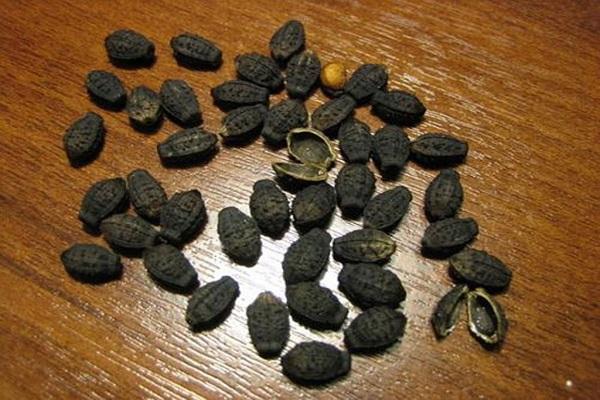

Cuttings
Sometimes seedlings are propagated using cuttings. Before planting, they are kept in a peat mixture for rooting for several weeks, after which they are transplanted into the garden.
Tuber
Some growers propagate mirabilis with tubers. They are carefully dug out of the ground at the end of summer and stored in a cool room until spring. Tubers should be planted in late April or early May.
Growing flowers for seedlings
There are several ways to plant mirabilis. Consider the first of these, when the seeds are first planted in pots. It is best to use this planting method until mid-April. Before planting in the ground, their strong shell must be slightly damaged with sandpaper, then place the seeds in a container that retains heat with water and leave for 24 hours. This manipulation will help increase the likelihood of seed germination.
The pots, in which the seeds will be for the first time, should be filled with the following composition:
- sod land;
- decayed marsh plants;
- humus (can be replaced with compost);
- clean sand;
- wood ash - oh, 5 cups per 5 liters of soil, or dolomite flour - 2 tablespoons per 5 liters of soil.
Mix all the ingredients well together and fill the pots with them more than half. It will be very good if you sprinkle the already packaged soil with a fungicide solution. Seeds are planted based on the ratio of 2 seeds to 1 small seedling cup. Then they are sprinkled with earth and sprayed with water.
When you see the first large leaf on the sprout, cut off the smaller one that is closest to the ground so that it does not interfere with the first one.
When the mirabilis reaches a height of 16 cm, feed it with mineral fertilizers. At the same time, you can begin to accustom the night beauty to external climatic factors. To do this, take it outside or place it under an open window for 2 weeks, increasing the time spent in the natural environment every day.
Recommendations
Mirabilis is practically not attacked by insects. Watering should be monitored to prevent permanent stagnation of water in the soil, waterlogging causes fungal infections - rust or spotting.
It is necessary to fight these infections by regulating watering, drying the site. At the same time, the affected flowers and leaves are collected and the soil is treated with a solution of fungicides, for example, Fundazol (10 g per 10 l of water).
Night is an attractive ornamental shrub with an unusual miraculous tropical scent of flowers.The plant is rarely found in household plots, but is confidently gaining popularity due to its unpretentiousness and unusual decorative appearance.
Transplanting sprouts into open ground
It is worth planting mirabilis in late spring, when the soil has finally warmed up. Around this time, they reach a size of 15 cm. Here are some tips for choosing a place to plant a night beauty.
- Plant flowers in an area that is well lit by the sun. The Mirabilis love it.
- The ideal soil for a night beauty is clay or loamy with a little lime.
- Too wet soils are enemies of the night beauty, since the plant does not like a lot of moisture.
- It is worth replanting mirabilis in pits together with the soil that was in the pot. Therefore, make sure that the holes are fairly deep.
- Two hours before planting in open ground, the flowers are watered to make them easier to remove from the pots.
At the end of all planting work, water the night beauty again abundantly.
Description of mirabilis
The flowers of mirabilis come from the USA. They came to Europe thanks to the Spaniards. With their help, they learned about the plant in North African countries, Morocco and Egypt. Very soon mirabilis Yalapa became one of the favorite adornments of European, Egyptian, Moroccan parks and gardens. The mirabilis plant is easy to grow, but you need to know some nuances. For example, the temperature of the air and soil should not be too high. The optimum range is 20-25 ° C.
Important! The soil should not be acidified, as the flower will not grow on it!
He also does not like waterlogged swampy areas. Therefore, watering is abundant and often unnecessary.


Mirabilis
The description of mirabilis flowers can often be found in poetry and prose, and can be seen on canvases. The color palette is very extensive. Dominated by:
- white;
- pale pink;
- bright pink;
- red;
- orange colors.
There are also varieties, the flowers of which include two or more colors that are close on the palette.
Growing mirabilis from seeds in the open field
Planting and caring for a night beauty flower will take less time if you plant them directly outdoors, as shown in the photo. To do this, you need to follow a few simple steps.
- Prepare the seeds for planting with sandpaper and a thermos. We described in detail how to do this in the paragraph on growing a night beauty for seedlings.
- At the end of April, make furrows up to 3 cm deep for the seeds.
- Plant the prepared seeds in the furrows several at a time. The distance between seed groups should be more than 40 cm.
- Lightly cover the furrows with soil and water the plantings with warm water.
- Until shoots appear, keep the planting sites covered with a non-woven material (film). If at this time in your region the weather is already quite warm without night frosts, then this step can be omitted.
- Have you heard of such a flower as Night Beauty? Vote
When the first shoots appear, they must be thinned out.
Planting tubers in spring
It is possible to plant non-sprouted rhizomes in open ground only after the ground has warmed up stably. The tuber is deepened by 20 cm, sprouting up. Pre-heating of the planting material is required indoors for a week. Pre-germination of tubers in a warm and well-lit place is permissible. You do not need to soak them, just sprinkle them lightly with warm water just before planting.
After waiting for the shoots to grow by 45 cm, you should choose the largest ones, and pinch the rest in order to get a powerful developed bush in the future.
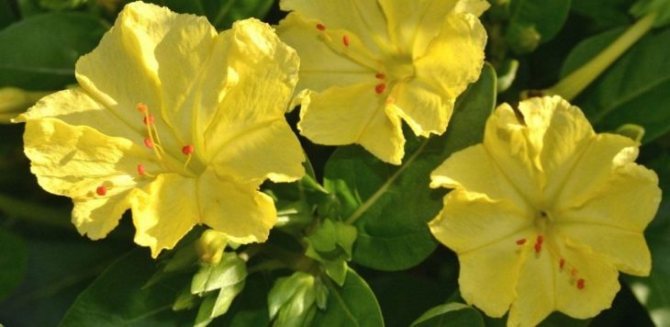

Night beauty care
Night beauty flower care, like planting, has its own nuances. But the result is worth it - just look at the photo and make sure of it. The main point is abundant watering. During drought, mirabilis should be watered with plenty of water up to 3 times a week.
If the summer is rainy, then there is no need to water the mirabilis at all. The soil around the flower must be periodically loosened and weeds removed. It is most convenient to do this after watering.
Mirabilis need to be fed several times during the season. You can use compost or humus as fertilizer. But fresh organic fertilizers, on the contrary, are not recommended. The night beauty also loves mineral fertilizers with a small percentage of nitrogen content.
Reproduction of mirabilis
Mirabilis reproduce in two ways:
- Sowing seeds. The seed of the night beauty is characterized by good germination. This method is considered the main one for the propagation of this plant.
- Cuttings. Slightly popular. However, it is also used for flower propagation. At the same time, it is necessary to make more efforts and it is not always possible to get the expected result.
Instructions propagation of mirabilis by cuttings:
- Dry branches are cut from the plant.
- Dry the cut site.
- The cuttings are soaked in the Epin or Zircon growth promoter.
- After a couple of weeks, the cuttings are planted in prepared soil.
- With proper agricultural technology, the cuttings will take root within 15 days.
Watch the video! Mirabilis. How to grow from seeds
Signs of diseases and pests
The night beauty is famous for its high resistance to diseases and pests. Moreover, practically no pests can attack mirabilis, and of the diseases there are only a few that summer residents should really be afraid of. Such ailments include root rot, which occurs as a result of too much watering.
As a pity, the night beauty flower will have to be removed from the ground despite all the efforts put into planting and caring for it. After all, such a beautiful flower, as in the photo, will definitely not grow, but will only infect other plants. For prevention, treat the soil at the site of growth of a diseased bush with a fungicide solution.
Rust and other types of spotting can also affect mirabilis, or rather, their leaves. You can get rid of this fungal disease by tearing off the infected leaves and watering the flowers with the same fungicide solution.
Flower night beauty: description, planting and care
Night Beauty is a perennial, but most often it is grown as an annual crop, propagated by seeds every spring. The flower is mainly bred in the open field. Low varieties are grown on a brightly lit loggia in pots.
Protection from pests and diseases
"Night Beauty" is disease resistant. But if the bush is regularly exposed to waterlogging and stagnation of water, this is fraught with the development of root rot. If the plant is already infected, it is recommended to dig it up and burn it so that the disease does not spread to other crops. Sprinkle the area where it grew with a fungicide solution (Fundazol).
Less commonly, mirabilis is affected by powdery mildew, rust. The fight against them is also carried out with the help of fungicides.
The culture is resistant to the attack of pests. Therefore, the problem of combating parasites in florists does not arise.
Night beauty mirabilis: description
Lush bushes of a plant in height are not lower than 40 and not higher than 80 cm. The root system is tuberous. The stem is erect, lignified. One tuber grows 5–7 highly branched stems with opposite, elongated longitudinally ovate leaves of bright green or dark green color.
Night beauty is a flower that is grown for scent
The flowers of mirabilis are funnel-shaped, from 2.5 to 5 cm in diameter and from 4 to 6 cm high, collected in corymbose inflorescences. The buds bloom and are tied in turn. The flower lives for about 20 hours, then falls off. The color of the buds is predominantly pink, but it can be yellow, orange, crimson. On the same plant, multi-colored flowers often appear at the same time.
Description
Mirabilis Yalapa or Night Beauty is a representative of the genus of Mirabilis flowers.These are perennial herbaceous plants imported from Mexico. Under natural conditions, the flower grows in tropical forests. Today it is successfully grown in temperate climates.
Mirabilis is often grown as an annual. In cool regions, the aerial part of the mirabilis dies when winter sets in. The tubers are saved to grow the flower next year.
The height of the bush is from 30 cm to 1 m. The stems of mirabilis are powerful, fleshy, erect or creeping. The root is thin, rod type. The plant forms tubers that help to withstand drought and cold snaps.
Mirabilis leaves Night beauty of dark green color, simple, oblong, pointed at the ends. Most of the leaves are located at the top of the shoots. The flowers of mirabilis are single, grow in corymbose inflorescences, have the shape of a funnel up to 2.5 cm in size.
The color of mirabilis depends on the variety. One bush can produce flowers of various shades from orange to purple. Often there are specimens with multi-colored petals.
Important! Mirabilis Night Beauty blooms from mid-summer for several months.
The flower got its name from the Latin word "mirabilis", which translates as "amazing". It is called a night beauty because of its bloom at night.
Mirabilis flowers bloom after 4 pm and close only at dawn. In cloudy weather, the buds bloom during the day. The plant gives off a delicate pleasant aroma.
After flowering mirabilis, a large dark brown fruit is formed. Each box contains one seed. After harvesting, the shelf life of planting material is up to 3 years.
Photo of Mirabilis Night Beauty:


Choosing a site for planting mirabilis
The flower is of southern origin, therefore it is sensitive to heat and light. Despite blooming at night, the plant needs good lighting during the day, so it is necessary to plant mirabilis in areas open to the sun. In the shade, the flower grows slowly and forms small buds.
The second important aspect is the inadmissibility of excessive moisture. In places of frequent accumulation of moisture, the roots of a night beauty quickly rot. Ideally, it should be planted on a small hill, on soil with good aeration properties or with a drainage layer. The soil should be light, slightly acidic, loamy or peaty-sandy. Dolomite flour or wood ash will improve its performance in case of high acidity.
Bush formation
Night beauty lends itself well to any shape and does not require any special skills. It can be cut, pinched, without fear that the plant will be harmed. From this it becomes even more beautiful and attractive. The bush, formed in the form of a ball, which is completely covered with bright flowers in the evening, looks especially impressive.
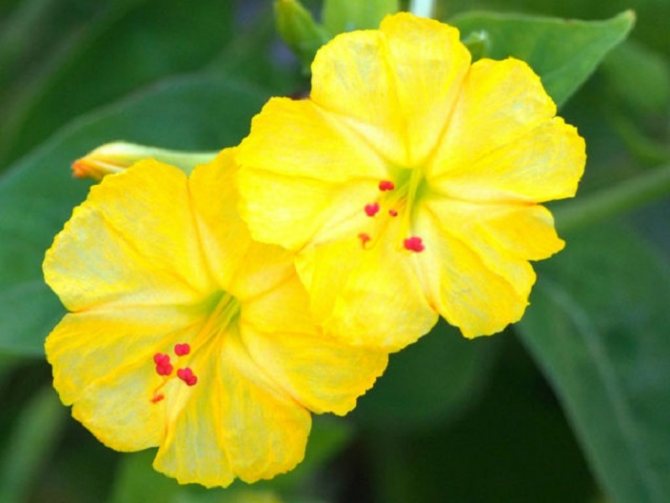

The combination of mirabilis with other flowers in a flower bed


Landscape designers appreciate mirabilis and actively use it in their compositions. So, undersized varieties go well with the following plants:
- peonies;
- delphinium;
- tall garden roses.
Tall mirabilis look great next to small trees and shrubs, as well as in single compositions.
"Night Beauty" is suitable for those who love fragrant plants with lush flowering caps. Its cultivation is within the power of even a novice gardener. The plant does not require close care, and the result will always be spectacular.
Planting miscanthus
- Flowering: from July to autumn frosts. Flowers open in the evening and close in the morning.
- Planting: sowing seeds for seedlings - in early or mid-April, planting seedlings in open ground - in the second half of May. Sowing seeds directly into the ground - in early May.
- Lighting: bright sunlight.
- Soil: fertile clay or loamy soils of slightly alkaline reaction.
- Watering: periodic, but plentiful.In extreme heat and drought - from 1 to 3 times a week, but in a season with normal rainfall, you can not water the site at all.
- Top dressing: 2-3 times per season with complex mineral fertilizers: before the beginning of bud formation, in the middle of summer and at the end of August. From organic fertilizers, humus and compost are used, and mineral compositions introduced in the second and third periods should contain a minimum amount of nitrogen.
- Reproduction: seed.
- Pests: not affected.
- Diseases: root rot, rust, spots.
- Landing: from late March to mid-May.
- Flowering: in the second half of summer.
- Lighting: bright sunlight.
- Soil: moist, fertile, near the reservoir. Miscanthus grows poorly on heavy clay and sand.
- Watering: regularly and abundantly, you can use a hose.
- Top dressing: regular and moderate, three times per season, starting from the second year: in mid-May - with a solution of urea, in the first half of summer - with humates, in the second - with potassium-phosphorus fertilizers.
- Reproduction: by seeds, but more often by dividing the bush in the spring.
- Pests and Diseases: The plant is extremely resistant to both disease and pests.
Miscanthus flower is a perennial from 80 cm to 2 m in height with creeping rhizomes, which in search of food can reach a depth of 6 m, erect shoots, scaly leathery leaves 5 to 18 mm wide and fan-shaped panicles 10 to 30 cm long, consisting of spikelets ... Miscanthus is unpretentious, hardy and environmentally friendly, it is of interest not only for its decorative effect, but also as a fuel for power plants, since during its combustion a large amount of energy is released while forming a minimum amount of ash due to the low moisture content of the raw material.
Planting miscanthus is carried out in the spring, when the soil warms up - from late March to mid-May. Miscanthuses are thermophilic, so they should be planted in well-lit and sun-warmed areas, protected from the cold wind. But even more than warmth, Miscanthuses love water, which is why they prefer moist, fertile coastal areas. The quality of the soil for miscanthus is not very important, but they grow worst of all on sands and heavy clays.
If you decide to grow miscanthus on the plot, buy adult seedlings: this plant has a very long growing season, since the thermophilic miscanthus starts growing only when the air temperature reaches 25 ºC, so the young seedling simply will not have time to settle down and get stronger before the onset of cold weather.
An adult seedling has a greater margin of safety, and with good shelter it can painlessly survive even a cold winter. A layer of fertile soil is placed in the planting hole, which should be slightly larger in volume than the root system of the seedling, then the seedling is lowered into it and the voids are filled with earth, gradually tamping it. After planting, miscanthus is watered abundantly.
Plant lovers argue that there is no worse spectacle than drying up miscanthus, so do not forget to water it, especially during hot dry seasons. It is best to use a hose to water the miscanthus - the more abundant, the better. The cultivation of miscanthus also involves regular but moderate feeding, since an excess of nitrogen, for example, leads to lodging of the plant.
In the first year, miscanthus is not fed, and in the future, fertilizers are applied twice a season: in mid-May, liquid fertilizing with nitrogen fertilizers is required - for example, a urea solution. In the first half of summer, the site is watered with humates, and in the second, potash-phosphorus fertilizers are applied. When starting to grow miscanthus, tune in to constant weed control, at least in the first two years of the plant's life.
By the way, the growth of miscanthus in the garden will have to be limited, otherwise you, besides this picturesque reed, will not be able to grow anything else.This is done immediately after planting: the limits in which the plant should remain are outlined with a limiter. You can use pieces of iron or slate as a limiter.
By the end of summer, some species of miscanthus lose their lower leaves, and this reduces the decorative effect of the plant. To disguise the lower thinning part of the bushes, it is best to plant a high hostu on the site - 50-60 cm in height, quietly growing in conditions of excessive soil moisture, without which miscanthus cannot do.
That is, perhaps, all that can be said about the cultivation of this cereal. Planting and caring for miscanthus in the open field is not laborious, and the beauty and effectiveness of this plant can hardly be overestimated.
Miscanthus does not like changing places, however, over time, the shoots in the center of the bush die off, so it becomes necessary to transplant a plant, which is combined with dividing the bush - one of the most reliable vegetative ways of propagating miscanthus. The bush is divided in spring or early summer, the procedure is carried out very carefully, since miscanthus recovers after injuries for a long time and painfully.
Plant propagation by seed is also possible. Miscanthus seeds do not need pre-sowing treatment, however, the generative method of reproduction will require patience and will take a lot of time, since a plant grown from seeds acquires attractiveness only in the third or fourth year.
Seeds are germinated in peat pots, and with the onset of spring, after the soil has completely thawed, they are planted in open ground. We remind you that miscanthus does not retain varietal characteristics during seed propagation, therefore the overwhelming majority of gardeners prefer to propagate miscanthus vegetatively.
About diseases and pests that can infect miscanthus, nothing is known. It is a very healthy plant.
There are types of miscanthus that are resistant to cold weather, and there are those that need mandatory shelter for the winter. Delicate varieties must be protected not only from frost, but also from sudden temperature changes. If the cold snap sets in gradually, then the plant has time to adapt to changes in nature, but if frosts broke out unexpectedly, it may die.


But do not forget to mulch the site before building the shelter and protect the roots from freezing with a thick layer of any loose soil.
Most likely, it is a complex hybrid that has long been familiar to gardeners, but the origin of which can only be guessed at. Its erect stems reach a height of 3 m, weeping dark green leaves with a white stripe along the midrib, leaves up to 25 cm wide, extending from the stem in all directions, make the plant look like a large fountain.
Most often, this view is used as an accent in the background. It requires masking the lower part of the stems due to the leaves dying off in the second half of summer.
It grows naturally in China, Korea, Japan and Russia. It is a perennial grass with a loose bush, short rhizome and erect stems up to 3 m high. Its leaves are linear, hard and rough, up to 1.5 cm wide, with a rough rib along the median vein. It blooms with single-flowered spikelets up to 7 mm long, collected in loose panicles. In culture, the species has been since 1875, its winter hardiness is relative, therefore, dry shelter and mulching for the winter are required.
We offer you to familiarize yourself with: Brunner planting and care growing from seeds
Chinese miscanthus is the most popular species in culture; today more than a hundred of its varieties are known, which differ in color and shape of inflorescences, sizes and outlines of the bush. Among them there are both thermophilic plants and those that are safely grown in the middle lane. For example:
- Blondeau - bush height up to 2 m, cold-resistant - hibernates without shelter;
- Variegatus is a loose bush no more than one and a half meters high with white longitudinal stripes on the leaves;
- Miscanthus Zebrinus, sometimes called Miscanthus Zebrina, is a variegated plant with transverse yellow stripes over green leaves;
- Ferner Austin - up to one and a half meters high, on narrow graceful green leaves a white stripe along the midrib, changing color to reddish-red in autumn. Fan-shaped, bright red panicles with white tops that bloom in August gradually become silvery-bronze;
- Morning Light is a graceful, low plant with narrow, white-edged leaves. Unfortunately, this variety blooms late and not every year;
- Strictus is a miscanthus up to 270 cm high with bright variegated leaves up to 1.5 cm wide, along which transverse bright white and green stripes alternate, and reddish single-flowered spikelets in loose panicles.
It grows in Russia in humid areas from the Amur Region to the south of the Primorsky Territory, as well as in Korea, China and Japan. This plant is up to 2 m high with bare stems, linear light green drooping leaves up to 60 cm long and up to 1.5 cm wide, blooming with white or silvery pink panicles up to 25 cm long.
It is cold-resistant, hibernates without shelter, but mulching the site in case of absence of snow is desirable. The most popular form is Robustus - a plant larger than the main species.
- Planting: in the spring, before the start of sap flow, or in September.
- Lighting: bright sunlight.
- Soil: well-drained, light and loose, in an area with deep groundwater.
- Watering: infrequent, even in drought: 2-3 times per summer with a water consumption of 10 to 30 liters per plant, depending on its size and age.
- Air humidity: in heat and drought, once a week in the evening, the plant is sprayed with cold water.
- Top dressing: in April or May - with a solution of Nitroammofoska or Kemira-lux.
- Pruning: Sanitary cleaning or formative pruning is carried out as needed in the spring or fall at a garden temperature of 4 ˚C.
- Reproduction: seeds, layering, grafting, cuttings.
- Pests: do not strike.
- Diseases: brown shute, nectriosis of the bark of branches, biatorrel crayfish, alternaria, drying out of branches, fusarium and rust.
- Properties: the shoots of the plant contain poisonous sabinol oil.
Features of growing mirabilis


Initially, mirabilis was considered a horticultural culture, which was actively used to decorate flower beds. But thanks to ardent lovers of the plant, it gradually migrated to the windowsills. For indoor cultivation, it is customary to use undersized varieties. They are planted in spacious pots and placed on the south side. In summer, homemade mirabilises can be taken out onto a balcony or terrace, but they need protection from the wind. Strong gusts can break the delicate stems.
Types of mirabilis
Mirabilis is rich in bright colors:


crimson,- purple,
- red,
- pink,
- yellow,
- white
- and orange flowers.
Their diameter is from 3 to 5 centimeters, can be monochromatic, variegated, where two or three colors are combined.
More varieties are planted in gardens with white, yellow and pale pink flowers. More colorful night beauties, with interesting details of the drawing, are best placed where you can get close to them.
Grade "Marble" mirabilis has stripes of different colors, different widths, strokes, multi-colored splashes.
If you follow the simple rules for caring for a night beauty plant, then any gardener on his site will be able to grow such a plant with very beautiful and bright flowers with a wonderful aroma.
Amazing flowers
The fact is that these flowers bloom in the evening, when all the others are closed, and are pleasing to the eye all night. They close the petals with the first rays of the sun. During the day it is an inconspicuous, even and neat bush. Flowers on it are practically invisible. Its time is evening and night.
This property is associated with its Russian name - night beauty, since it is at night that the bush is covered with bright pink or white flowers, which emit a surprisingly delicate and, at the same time, spicy aroma.Through the efforts of breeders, new colors of the night beauty have appeared. Flowers can be purple, yellow with pink accents, orange, red.
This flower was brought to Europe from the American continent and quickly adapted. Gradually, he began to grow in almost all European countries, as well as in Asia, where he was loved for its unpretentiousness and amazing property - to bloom at night, spreading a wonderful aroma.
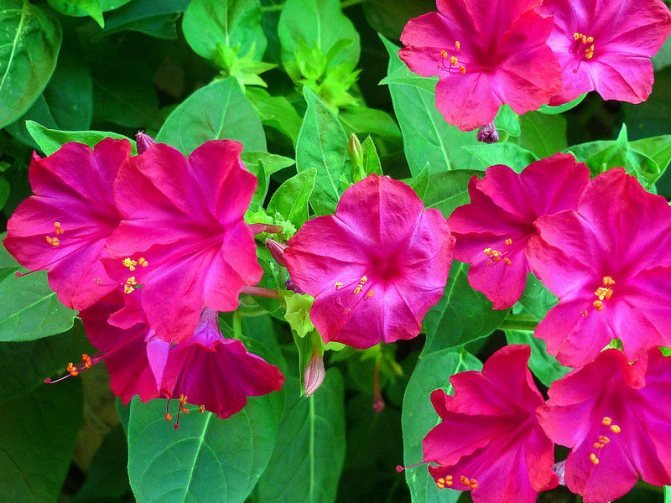

Flower in winter
When the winter cold comes, lovers of mirabilis should first of all take care of its tubers. The night beauty is quite capable of surviving the winter, the main thing is to correctly provide the conditions for "hibernation".


It is important to prepare the flower for winter
| Sequencing | Description |
| Tubers are carefully removed from the garden. |
| They are immersed in a pot or container. |
| Sand and peat are poured into containers. |
| The substrate is well watered and the flower is left in a well-lit place. |
Such a plant is stored in a dry and cold room with an air temperature of about five degrees Celsius.
On a note! Lower temperatures can kill the tubers.
When and how to plant?
- For the southern regions, the landing time for the night beauty is April.
- In central Russia, you can plant a flower in May. For those who want to plant them a little earlier, you should consider covering them with foil or agrofiber.
- For the northern regions, it is better to prepare seedlings indoors and, as soon as the weather is constantly warm, plant the seedlings in the ground. Peat cups are good for this.
The capacity for seedlings should be chosen high, since the roots of mirabilis go deeper.Seedlings must be hardened before planting, then they are easier to adapt in the open field.
- When sowing seeds into the soil, the grooves should be shed well. Planting material does not need to be soaked, their germination is excellent.
- Choose alkaline, loamy or clayey soil. The plant does not like acidic soil. If there is such a soil, it is worth adding lime.
- The place must be sunny.
- Dwarf varieties are planted at a distance of 25-30 cm, tall ones - 50.
Step-by-step instruction
- A sunny area is being prepared.
- Freed from weeds and debris.
- The soil is dug up and the grooves are prepared.
- Then spill them well with water.
- The seeds can be soaked before sowing, but they have excellent germination without it.
- Planting material is sown to a depth of 2 cm.
- In order to protect them from frost or for better germination, they can be covered with foil.
- As soon as shoots appear, and the weather will not portend frost, the shelter is removed.
- When 3 leaves appear, the seedlings dive.
- Leave the distance between seedlings 25-30 cm (tall varieties - 50).
- Two weeks after germination, you can make the first groundbait with complex fertilizers.
End of flowering
The plant blooms from spring to autumn. After it fades, you need to cut off the stems and dig up the tubers. The collected seeds are poured into paper bags or cloth bags and harvested until spring in a dry, dark and cool place. The seeds are covered with a strong shell, so special storage conditions are not required.
If you want to plant a night beauty with tubers in spring, you need to dry them well and put them in a dark, dry and cool place. This could be a cellar or a shelf for storing vegetables in the refrigerator. The optimum temperature should be +5 degrees. If you follow these simple conditions, you can keep the tubers in good condition and grow a full-fledged, abundantly flowering plant from them.
In the southern regions of the country, tubers winter well in the ground. In the fall, you need to cut off the stems, fill the place where the flowers of the night beauty grew, with sawdust or straw. The tubers overwinter well and with the onset of spring the first shoots will appear, from which new bushes will grow with bright flowers and a pleasant aroma.


Mirabilis: growing from seed, when to plant for seedlings
As a rule, flowering plants love the sun and dissolve their buds under its warm rays. But there are flowers that prefer sunlight to moonlight, and one such plant is mirabilis. Popularly, this flower is better known as the dawn or night beauty. Mirabilis is very unpretentious, tolerates heat and drought well, blooms with bright inflorescences of juicy shades - it is not surprising that flower growers and landscape designers love it so much. The mysterious night beauty deserves to be noticed.
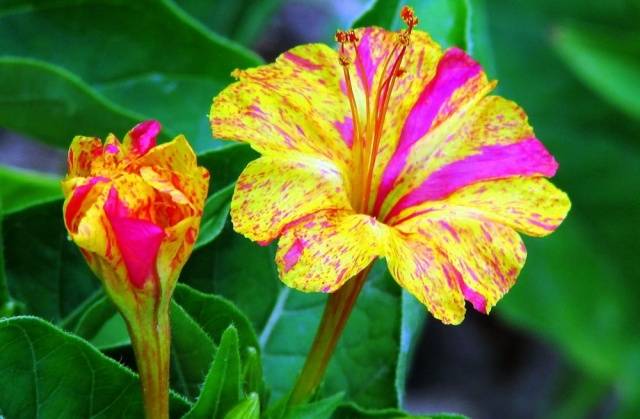

Growing mirabilis from seeds, when to plant this flower in open ground and seedlings, how to care for the plant, will be discussed in this article.
The birthplace of mirabilis is Mexico. For the first time, the ancient Aztecs drew attention to this plant, noting not only the amazing beauty of night flowers, but also their medicinal properties.
Attention! Mirabilis roots have been proven to contain a powerful laxative. The stems and leaves of the plant have anti-inflammatory and wound healing effects.


Later, the seeds of mirabilis came to Europe, where the flower quickly gained popularity and became widespread. If at home mirabilis is a perennial plant, then in colder climates it is grown as an annual - the roots of the flower are not able to withstand even minimal frosts.
Mirabilis belongs to a very rare family of Nocta or Niktagin plants. In the wild, there are about fifty species of night beauty, but only one of them, Yalapa, has taken root in Russia.


Characteristics of the night mirabilis:
- mirabilis yalapa - herbaceous plant;
- dawn bushes are compact, powerful;
- plant height can range from 50 to 120 cm, depending on the variety and growing conditions;
- the root system is powerful, the roots are tuberous, swollen - this is the structure that allows the flower to tolerate drought well;
- inflorescences look like gramophone;
- the color of flowers can be very different (from white to orange and purple), often there are inflorescences with stripes, specks, two-color mirabilis;
- the device of the mirabilis flower is surprising in that it completely lacks a corolla, and instead of an inflorescence - a calyx (in other plants it is painted green, has a small size);
- the diameter of the inflorescences can be 3.5-5 cm;
- mirabilis opens only at night, in cloudy and cool weather;
- mirabilis has a very rich aroma that attracts night moths and butterflies;
- each flower "lives" for only a couple of hours, after which it again rolls up into a tube and withers;
- the fruit of mirabilis is a wrinkled box of dark brown color, inside which there is one large seed;
- dawn bloom lasts from June until the first frost;
- the night mirabilis propagates by seeds, dividing the bush and lignified cuttings.
Important! Mirabilis is very unpretentious, therefore it is considered one of the best flowers for novice florists and busy owners.
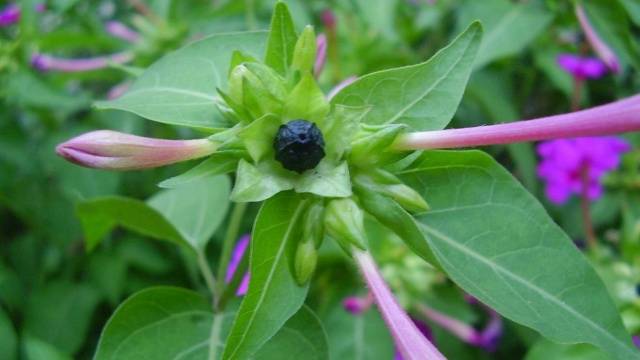

Since in Russia mirabilis is grown as an annual plant, it is more convenient to propagate it by seeds. Of course, a grower can cut a stalk from a bush or divide a flower by roots, but all these actions will not make sense, since in winter the plant will die anyway.
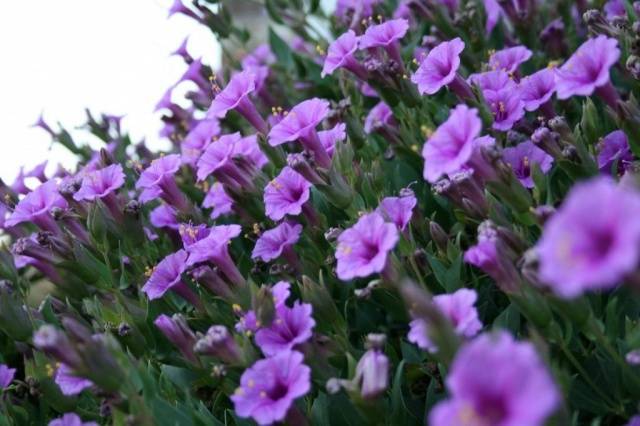

Attention! As an experiment, you can lower the cuttings or rhizomes into the basement and provide them with a suitable temperature. But practice shows that most of the plants will not survive until spring, and all these actions do not make sense, because mirabilis is perfectly propagated by seeds.
When choosing a place for a dawn in your garden, you must remember the tropical origin of this plant. Mirabilis is, indeed, incredibly unpretentious and capable of blooming even in the most difficult conditions and on clay soils, for example.But, if a florist dreams of lush bloom and large beautiful flowers, you need to provide mirabilis with just ideal conditions:
- find the warmest and sunniest place in the garden;
- think about the possibility of shading flowers in the afternoon (because of the strong heat, mirabilis may stop throwing out buds);
- protect flowers from drafts and strong winds;
- prepare slightly acidic or neutral soil;
- mirabilis is able to withstand drought, but excessive moisture is detrimental to this flower, so the soil must be well drained and not be in a lowland;
- the soil should be loose, nutritious, good for air and moisture.
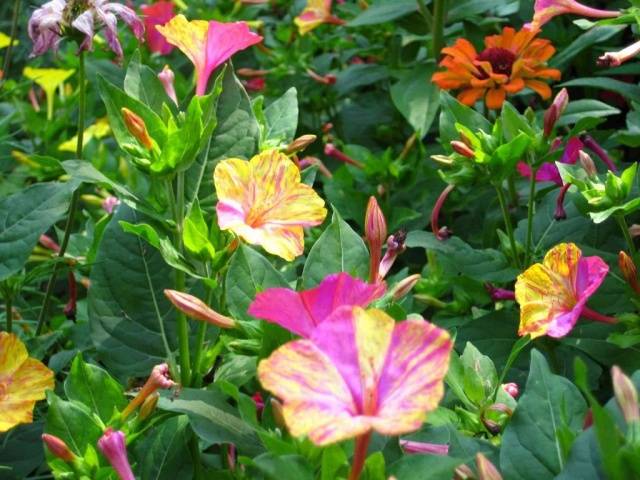

Advice! If the soil in the flowerbed is acidic, you must mix it with dolomite flour or quicklime.
In principle, the climate of most of Russia with long and warm summers and minimal rainfall is quite suitable for a night beauty. All this allows you to grow mirabilis from seeds at home, without resorting to buying seedlings.


Attention! Direct planting of seeds of a night beauty in the ground is possible in those regions where a stable warm temperature is already established at the end of April or in the first half of May.
To answer the question of when to sow mirabilis seeds on a flower bed, it is necessary to analyze the climatic situation in a particular region. To achieve flowering of mirabilis at least by the end of June, it is necessary to plant its seeds in the ground by the first days of May.


If by this time the soil has not warmed up well enough, and there is a threat of return frost, it is recommended to use mini-greenhouses. In such cases, large oval seeds of mirabilis are laid out in pairs at a distance of 20-30 cm from each other, deepening them into the soil by no more than two centimeters. After planting, the seeds are watered with warm water and covered with a transparent film. The film is removed when mirabilis sprouts appear from the seeds, and the weather stabilizes.
Advice! To speed up germination of mirabilis seeds, it is recommended to soak them before planting.
Growing mirabilis directly from seeds is an easy and quick process. However, for some growers, there may be a fundamentally earlier flowering of the dawn, or the climate in the region is cold, which does not allow early sowing of seeds in the ground. In such cases, mirabilis is grown in seedlings.
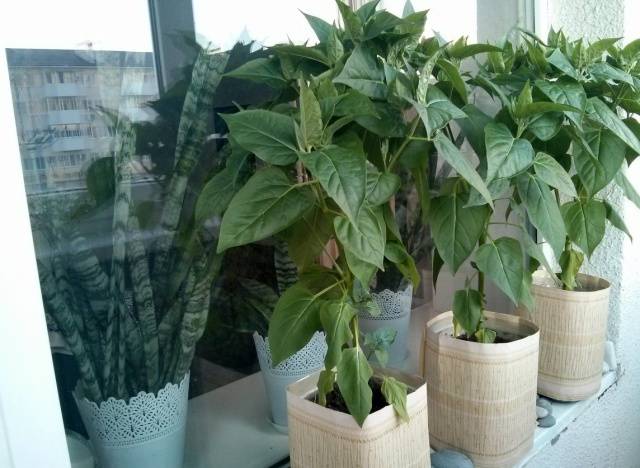

It is necessary to sow dawn for seedlings in the first half of April, in order to plant mirabilis in the ground in 1.5 months. Sowing seeds of a night beauty for seedlings is not difficult, but here you need to follow some rules:
- Choose deep cups or pots for planting flowers. The root system of mirabilis goes deep, and not to the sides, so the roots will need a lot of space.
- Prepare or purchase a ready-made substrate. The soil for seedlings is prepared from equal parts of sod land, peat and river sand.
- It is recommended to add a handful of wood ash to each pot just before sowing.
- The seeds of mirabilis should be soaked in a damp cloth for 12-20 hours (you can skip this, then the seeds will germinate a couple of days later).
- Place 2-3 seeds in each glass or pot. This seedling is quite large, the plants are powerful.
- The seeds are deepened by no more than two centimeters, sprinkled with dry earth on top.
- Water the plantings with warm water and cover with a transparent film.
Interesting: The perennials that adorn my garden in June
Now you need to remove the seedlings in a warm place with a constant temperature of 23-25 degrees. After 10-12 days, the seeds will germinate, then the shelter can be removed, and the pots can be placed on the windowsill.


Attention! Seedlings of mirabilis should be watered sparingly, as excess moisture will lead to its death. Only when the ground is completely dry can you water the flowers with a little water.


At the end of May, the seedlings of the night beauty are transferred to a permanent place.The wells are prepared in advance, leaving an interval of 30-50 cm between them (depending on the variety of mirabilis and the height of the bush) and fertilizing with a mineral complex.
With how to grow mirabilis from seeds, everything is clear. Now it's worth talking about the rules for caring for night flowers. Although the dawn is very unpretentious and usually does not cause any trouble to the owner of the site, like any cultivated plant, it needs minimal care:
- watering mirabilis needs regular, but not very frequent. During dry periods, it is recommended to water the flowers abundantly once a week. If the grower noticed that the number of inflorescences on the bushes has decreased, watering can be increased - after 1-2 days. When there is enough natural precipitation, it is not necessary to water the night beauty; she suffers from excess moisture more than from its lack.


- You need to feed the mirabilis at least three times per season. The first fertilizer should be complex and contain nitrogen, it is applied immediately after planting seedlings in the ground or before laying the buds. The second time the flowers are fed in the middle of summer, the third feeding is performed at the end of August. The last two dressings consist of a complex of minerals, but nitrogen is no longer needed at this stage, it will make the flowering more scarce.
- Diseases and pests almost never infect mirabilis, so there is no need to process the bushes.
- To keep the flowers strong and healthy, the soil under the bushes must be loosened after each rain or watering, and weeds must be pulled out.
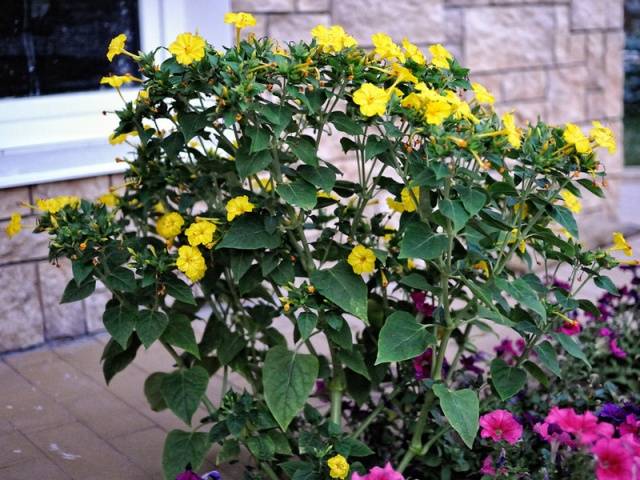

- In the middle of autumn, dawn bushes are dug up and disposed of, having previously collected seeds from mirabilis for the next season.
Important! In the southernmost regions with mild winters, you can try to keep the mirabilis until spring. To do this, with the onset of cold weather, the bushes are pruned and the roots are covered with a thick layer of organic mulch or spruce branches.
Photos of the blooming mirabilis do not leave you indifferent: it is not in vain that this flower was revered by the wisest ancient peoples (Aztecs, Egyptians). Dawn is rightfully considered the queen of the night, illuminating the garden with bright colors when other flowers fold their buds and sleep soundly.
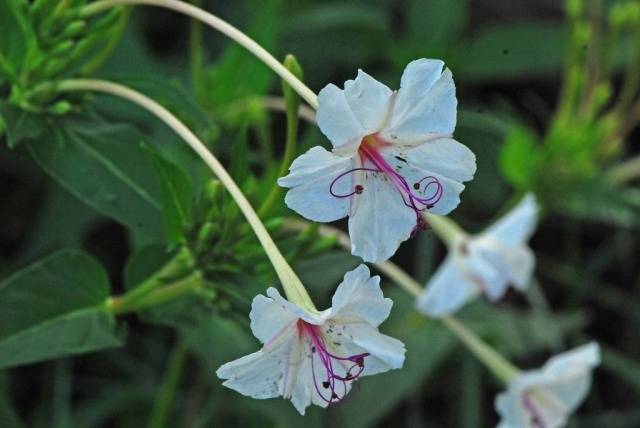

It is quite simple to grow mirabilis, for this you just need to sow seeds in the ground or plant them on seedlings. Complicated plant care is also not required, so the night beauty is perfect for the most inexperienced flower growers.
Mirabilis feeding rules
Fertilizing is a vital procedure for producing gorgeous, multi-flowered shrubs.
In the summer, the plant is fed three times using mineral formulations. In the event that you do not want to resort to the help of chemicals, it is permissible to add organic matter to the garden bed - bird droppings or mullein - in the area near the roots.


Mirabilis planted in the garden can be fertilized with bird droppings
A good effect is achieved by a humate tincture, which is watered in the same place.
Humate
On a note! The second and third feeding should be done with a substance with a low nitrogen content, otherwise flowering will be greatly inhibited.
Diseases and parasites
Inexperienced summer residents love this flower because it resists various harmful factors well. Usually, the flower can only suffer from rust and mottling. To get rid of this problem, diseased parts of the plant are removed, subsequently treating it with a fungicide.


Such a flower can get spotted.
As we have already said, for a comfortable life of mirabilis, it needs to provide warmth, so you should carefully consider where the flower will grow, and also determine the optimal planting time. It is undesirable to plant the plant before summer, because sometimes frosts return - because of the cold, mirabilis will not rise.
On a note! The night beauty does not like cold so much that she can respond to any gust of cold wind by curling the foliage. So it is important to protect the landing site from drafts.
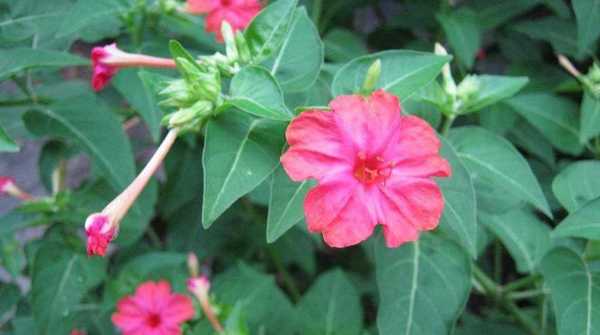

The plant does not like cold
Comments (4)
Masha
21.09.2018 at 00:19 |
I bought the seeds of a night beauty and planted it, neither of which I succeeded, only 1 bush came up and now it looks very frail, I plan to plant more, but this time ask my sister for seeds.Reply
Nadia
22.09.2018 at 00:43 |
And I also bought seeds of a night beauty, though on the Internet, so not a single bush sprang up at all. You just need to buy seeds from trusted people, then everything will work out.
Reply
Kira
17.10.2018 at 00:15 |
Is this by any chance the flower that flaps and makes sounds as it unfolds? It's just that one of my relatives has a very similar plant in the garden, when its flowers bloom in the evening, they clap.
Reply
Natasha
21.10.2018 at 04:18 |
The night beauty is not particularly whimsical in care, you need to strain only at the initial stage, while the plant gets stronger. If someone hasn't sprouted plants, then you bought defective seeds.
Reply
Pests, diseases
Night flowers do not suffer from the attack of pests, they are not at all afraid of them. Also, the plant is resistant to diseases. There are times when Mirabilis is affected by rust. This disease is the appearance of brown spots on the leaves. In case of illness, do not hesitate. Get rid of all infected foliage. The plant can be treated with a fungicide.
Another unpleasant disease is root decay. Mirabilis is usually affected by this ailment during the period of heavy rains due to high humidity. In this case, the damaged plant must be removed. Treat an infected area of land with a fungicide.
Characteristic
Perennial shrub with thick roots in the form of tubers. In our climate, it does not tolerate winter cold, so the Night Beauty is grown annually from seeds. In nature, there are about 60 species of shrubs, Mirabilis Yalapa and Mirabilis Himalayan are the most common and loved by gardeners. Plants do not require special care and are less susceptible to pest attacks.
Crown
The shape of the shrub is elongated-rounded, reaches a height of 30 to 80 cm. Stems are erect, densely covered with branches, lignite in the lower part. The shade of the bark is reddish, the leaves are opposite, on petioles, they are elongated, smooth, green.
Flowers


The flowers are funnel-shaped, with a large calyx (up to 2.5 cm in diameter) and a long tube (see photo). The color can be two-color or one-color, always bright - crimson, purple, orange, white, red, yellow. Shield-shaped inflorescences are collected at the apex.
Features of the
Mirabilis is native to North America. Flowers open in the evening, and wither very quickly, after a few hours. Pollinated by hawk moths - butterflies that fly at night. The faded flowers are replaced by new ones, this continues throughout the season, until autumn. The aroma is intense, very pleasant, tropical.
The fruits of the plant are dense capsules with one achene. The dark brown, ribbed fruits can be stored for up to 3-5 years, maintaining their germination capacity.
Application
Landscape designers use Mirabilis as a low decorative hedge, framed by paths and alleys. Tall varieties work well as a background placeholder in mixborders.
It is interesting: Columnar
The plant is used to decorate terraces, balconies, planting in deep large pots. Bushes look equally good both in single and in group plantings in the vicinity of marigolds, zinnia, chamomiles.
How to sow night beauty seedlings?
In cool climates, it is best to grow mirabilis in seedlings. While this may sound daunting, the reality is pretty simple. It is necessary in April to take medium-sized plastic cups and put the soil there from turf, peat and river sand.


You can grow mirabilis seedlings yourself
On a note! It is allowed to put a maximum of two seeds in one container, since the hatched mirabilis are quite large.
In just a few days, the plant will give the first signs of life, and after a month and a half, mirabilis can be transplanted to the garden bed.


After a month and a half, you can plant seedlings in the garden
General description, photo of flowers
Mirabilis is a herbaceous or shrub plant up to 1-1.5 m high. It has branchy, densely leafy straight shoots. The root system is tuberous, in appearance resembling a branched garden carrot. The buds are bell-shaped, funnel-shaped with a wide outer bell. The color of the buds is variegated and diverse, there are striped and speckled varieties.
Mirabilis migrated to Europe more than two centuries ago and managed to become "his own" in many countries with a warm southern climate, where it is a long-term culture. The cold climate of our country does not always allow the night beauty to survive the winter, therefore, among Russian flower growers, it is popular as an annual, which must be planted again every year.

